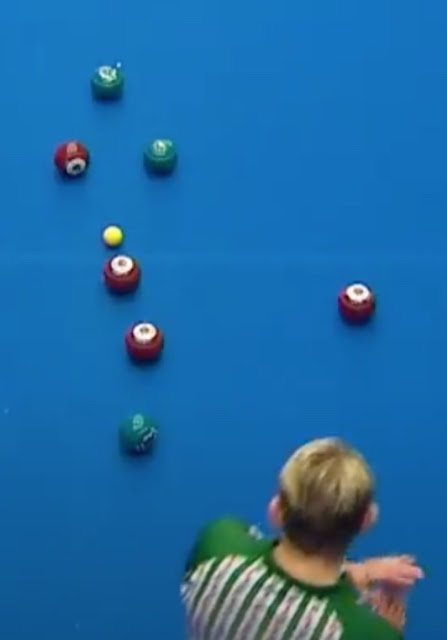Andy Thomson MBE is not among the top 14 bowlers as ranked in 2019-2020; nevertheless, he is among the top bowlers of all time and his delivery is the most distinctive of all. As such, it is worthy of analysis. Andy’s bowl delivery is not being presented as a model for imitators but as a mystery.
What sets Thomson apart, first and foremost, is that after sighting along his aim line he does not hold his stare point. Prior to starting his delivery action, he is looking at his feet!
Second, unlike other top bowlers he releases his bowl with a flick of his fingers to provide some spin to the bowl. Other bowlers either let the bowl roll off their fingers, or draw their fingers away from the bowl in a characteristic fashion.
Finally, like the delivery of David Bryant, Andy Thomson rises up to delivery his bowl rather than bending down. He rises, lifting his bowl from a position touching the rink in order to make a short backswing before starting it forward. Unlike Bryant who initially squats to sight his delivery, Thomson is completely upright, bending forward with legs straight as if to touch his toes.
But let us analyze step by step.
Grip
Before gripping the bowl, Andy licks his baby finger. I do not know why he does this. The only hypothesis I can imagine is that it reminds him that he needs to keep his baby finger off the bowl. His grip is the three-finger claw grip with the three fingers under the bowl placed with the index finger in the groove, his middle finger on the running surface and his third finger in the groove opposite. His thumb is either in the grip groove or slightly towards the running surface. I have difficulty identifying the exact position of Andy’s thumb. His three fingers are not parallel with the running surface of the bowl but their tips lie on an imaginary line at an angle of about 45 degrees to the line of the running surface.
Stance
Thomson stands with his feet parallel and side by side. He bends at the waist and not at all at the knees; in the pose of someone exercising by touching their toes. He slowly lowers the bowl until it just touches the ground. His non-bowling hand rests at the side of the bowl with fingers extended steadying the bowl.
Before taking this pose, he has looked carefully at the length and line but when his head is bowed in this pre-delivery pose, he cannot possibly see any stare point that is not within a few feet of his feet.
 |
The Wobble-Stagger??
|
Delivery
Andy uses very little backswing. His free hand hangs loose and is not used to steadyhimself. Furthermore, his entire body seems to wobble as he sends forward his arm and releases his bowl.
I cannot understand why Andy Thomson would choose this delivery style unless he has a back problem that he is trying to avoid aggravating. There is a faint suggestion that this might be true. He regularly moves his non-bowling hand to his back at waist height as he rises after each delivery as if to ease a twinge of pain.


















